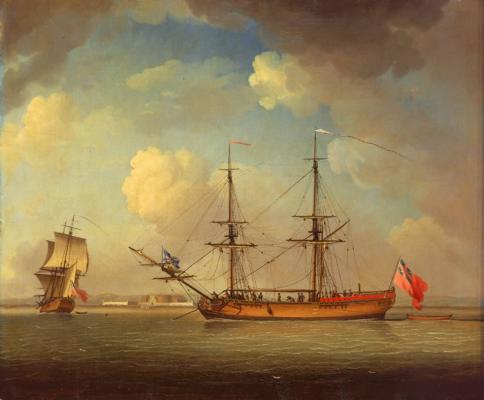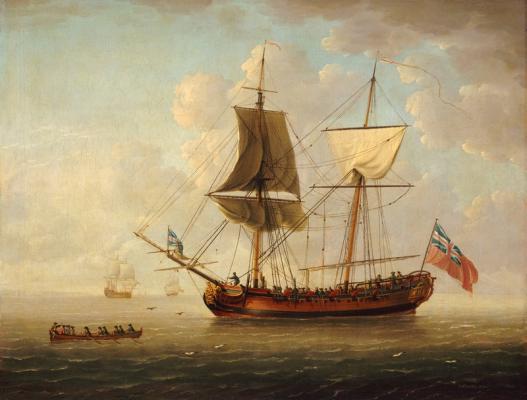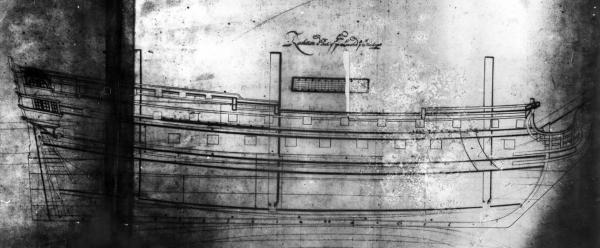-
Posts
841 -
Joined
-
Last visited
Content Type
Profiles
Forums
Gallery
Events
Everything posted by michaelpsutton2
-
Might I suggest that you look in Lee's Masting & Rigging English Ships of War. There are a couple of easy to understand drawings . The fid went though the bottom or heel of the topmast from side to side not fore & aft the two ends of the fid protruded far enough on each side to rest on an iron plate mounted on top of the tressletrees. The height of the hole for the fid above the heel of the mast varied a little over time but a figure of 2-3 times the diameter of the mast would get you in the ball park. The manufacturer of your Constitution kit may consider the fid to be too small to depict at that scale This post on our site may help: http://modelshipworld.com/index.php?/topic/332-hms-pegasus-by-blue-ensign-victory-models-enhancing-the-kit-a-build-log-of-sorts/page-12
-
Here is an English "snow from the 1750's. The difference between a snow and a brig is that the snow has a small pole or mast just aft of the main mast. It stands on the deck and is secured under the main top. The driver or later spanker is laced to this smaller pole instead of the main mast itself. The sail is shown brailed to the gaff & mast. There is no boom. It appears as was often the custom, the same vessel is shown from the stern sailing away from the viewer. It can be seen that the driver/spanker is not extended past the stern with a boom as was common beginning in the 1780's.
-
I wouldn't mind seeing a picture or two
-
Both of books are excellent but do not expect that either one shows the ship exactly as it is today or at Trafalgar. You will need to use multiple sources and even then make a couple of choices. The focsle bulkwarks are one of the most contentious issues. The carvings on the taffrail are another. Not to wax too poetic. But a real wooden ship is a living thing. It changes continously if slowly over time. These national treasures that are preserved for hundreds of years also reflect the vision of thier successive caretakes over the years Good luck and please post picture of the results
-
I see a good many draughts which have the rudder a tad higher than the bottome of the keel. The idea was to avoid damaging the rudder if the ship grounded. Sometimes the difference was just the thickness of the false keel or shoe. Sometimes the foot of the rudder sloped up as it went aft. I call your attention to the model of the cutter #SLR0519 in the National Maritime Museum or the draughts ZAZ6490 unamed cutter, ZAZ6425 Racer, ZAZ6274 Curlew, and ZAZ6343 the Pitt of 1763 all have the rudder offset from the keel. The Berwick a storeship of 1781 (ZAZ5405) has a rudder that slopes up as it runs aft On the other hand ZAZ6344 Fly, Zaz6498 and others show the rudder even with the bottom of the keel. So in the absence of any definitive info on the Sherbourne you could have it either way I would whole heartedly agree with Stockholm tar that the gap at the post is too large and would create drag Keep the pic's coming! It's looking better and better
-
The "Powerhouse Museum in Sidney, Australia has a lines plan used to build the model in the London Science Museum. I do not know why you should have to go to the museum in Sydney for the line to the model in London. It makes no sense. From what I saw on the website, the plan in Sidney seems to hace a little more sheer than Macgregors.
-
David Macgregors "Fast Sailing Ships" has a large fold out of the sail plan and the builders list of masts and yards, as well as the lines plan. The entry in the tea clippers is a slightly abridged version of the information in Fast Sailing ships. I have never seen a builders deck plan.
-
Just astounding. I am going to pitch all my tools in the ditch out front and take up whistling or something
- 883 replies
-
- royal caroline
- ship of the line
-
(and 1 more)
Tagged with:
-
For centuries the guys who built in the traditional 1:1 scale used wedges placed all the way around the mast at the upper deck. A canvas "coat" was then used to keep water from leaking in between the wedges. In addition to allowing them to fine tune the rig when it was in use, it took some of the pressure off of the builders. I guess in practice the fore and aft trim of the vessel would affect the angle of the masts as well. I think there is an illustration of this in Harold Underhill's "Masting & Rigging: The Clipper & Ocean Carrier". I will check when I get home. Is it a violation of the rules to share the pic on this forum if it is there? I am sure the book is still under copyright. I did properly render unto Ceasar to obtain the book.
-
My local library got this one for me. Don't just use the catalog. My local (Mandeville,Louisiana) library can borrow almost anything I need from as far away as the Library of Congress
- 5 replies
-
- Abel Tasman
- Heemskerck
-
(and 7 more)
Tagged with:
-
How do you make those spherical ventalators?
- 113 replies
-
- heinrich kayser
- steamship
-
(and 1 more)
Tagged with:
-

Painting the 1/180 scale HMS Victory
michaelpsutton2 replied to ronald305's topic in Plastic model kits
I think that the dust jacket from the Anatomy of the Ship volume on the HMS Victory should answer most questions. You can find low res copies of the cover on the internet -

Gun port lids and sweeps, on small vessels
michaelpsutton2 replied to Stockholm tar's topic in Wood ship model kits
My compliments to Jmaitri for a very thought provoking comment. I consider my self to be a good researcher and his "fallacy of authority" concept is as neatly phrased as any I have seen, Please teach me about sweep ports. On the draughts they are mostly square (pleae note I never use the forbidden word ALL). There are a few that are round with a slot to pass the blade of the sweep. Do they pierce a frame or are they situated between frames with short lintels above and below like ports? Were they the same size in the inboard and outboard sides? What was it like, attempting to row with a round peg inserted in a square hole through a bulkwark as much as a foot thick? Were there some kind of fitting in the sweep ports to make them a little more oar friendly. If I were a designer I would tend to make my sweep ports shaped like a truncated cone with the small end inboard. Lastly I have seen some models with lids on the sweep ports, but mostly when these ports were placed below the weather deck -
Thanks
-
I would like to address the question of gunports directly above each other. I have never seen a draught which placed the gunports on a dedicated "gundeck" directly in line with the ports of an adjacent dech. But beginning about 1660 or so the ports on a quarter or poop deck could be arranged without regards to the ports on the gundecks below. There is frequent reference to the portson the quarterdeck being crowded together to reach the "rated" total. Look at the famous model of the HMS Sussex in the US Naval Academy Museum or the HMS Prince (1670) in the Scince Museum collection Later in the 19th century as frigate quarter decks began to be rearmed with carronades the ports would be distributed without taking the ports on the gundeck into consideration. As an example the famous sail plan of the USS Constitution (C&R 27-15-18) as opposed to any of her seceral design draughts. I would also caution you to measure carefully. The "minor ports" are not always evenly spaced.
-
I use "anchorseal" . It's a commercial product. My brother-in-law gave me about a half of a gallon after he found me outside waving my fist at heaven and cursing a cold unfeeling universe. Nothing worse than drying a piece of wood for six, eight or ten months and have it develope a horrendous split on the very last day. By the way he tells me the correct term for end slpits caused by drying is "check". The wood developes end checks. I didn't pick this product. I didn't pay for it. I didn't know anything about it. But has worked pretty well. And unless there is a shelf life issue I think the half gallon will last most of my remaining lifetime. I strip off the bark. put it on the end and about a inch up the sides. It prevent new checks. Doesn't do a thing for existing problems. Somtimes I wish there was a way to see inside a balk before I waste all that time and effort. I agree that oak, particularly my local live oak and red oak are poor choices for small parts because of the grain and the fibers.
-
The latest and, I guess, finalt volume in Rif Winfield's series on the British Navy is available for pre-order. "British Warships in the Age of Sail 1817-1863" is on Seaforth Publishing's website. I have the first two volumes but for some strange reason the price on Volume 3 "1792-1817" is in the thousands of dollars. So I am getting an order in early for Volume 4. Although I do wonder if there is much new material not found in the Sail & Steam Navy by David Lyon
-
Would anyone care to recommend a cad program for drafting ships? I have a non-intel g5 mac runnning OSx 10.5.8 I would like to use it to create usable sheer & profiles from incomplete and poorly legible originals. An example would be this draught of the HSM Resolution 1705 or maybe 1708 (I can't remember which).
About us
Modelshipworld - Advancing Ship Modeling through Research
SSL Secured
Your security is important for us so this Website is SSL-Secured
NRG Mailing Address
Nautical Research Guild
237 South Lincoln Street
Westmont IL, 60559-1917
Model Ship World ® and the MSW logo are Registered Trademarks, and belong to the Nautical Research Guild (United States Patent and Trademark Office: No. 6,929,264 & No. 6,929,274, registered Dec. 20, 2022)
Helpful Links
About the NRG
If you enjoy building ship models that are historically accurate as well as beautiful, then The Nautical Research Guild (NRG) is just right for you.
The Guild is a non-profit educational organization whose mission is to “Advance Ship Modeling Through Research”. We provide support to our members in their efforts to raise the quality of their model ships.
The Nautical Research Guild has published our world-renowned quarterly magazine, The Nautical Research Journal, since 1955. The pages of the Journal are full of articles by accomplished ship modelers who show you how they create those exquisite details on their models, and by maritime historians who show you the correct details to build. The Journal is available in both print and digital editions. Go to the NRG web site (www.thenrg.org) to download a complimentary digital copy of the Journal. The NRG also publishes plan sets, books and compilations of back issues of the Journal and the former Ships in Scale and Model Ship Builder magazines.





